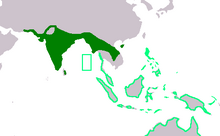Great stone-curlew
| Great stone-curlew | |
|---|---|

| |
| At Chambal River, Uttar Pradesh, India | |
| Scientific classification | |
| Domain: | Eukaryota |
| Kingdom: | Animalia |
| Phylum: | Chordata |
| Class: | Aves |
| Order: | Charadriiformes |
| Family: | Burhinidae |
| Genus: | Esacus |
| Species: | E. recurvirostris
|
| Binomial name | |
| Esacus recurvirostris (Cuvier, 1829)
| |

| |
E. recurvirostris range E. magnirostris range
| |
The great stone-curlew or great thick-knee (Esacus recurvirostris) is a large wader which is a resident breeder in tropical southern Asia from India, Pakistan, Sri Lanka, Bangladesh into South-east Asia.
Taxonomy[edit]
The great stone-curlew was formally described in 1829 by the French naturalist Georges Cuvier and given the binomial name Oedicnemus recurvirostris.[2] The type locality is Nepal.[3] The specific epithet recurvirostris combines Latin recurvis meaning "bent backwards" with -rostris meaning "-billed".[4] The species is now placed in the genus Esacus that was introduced in 1831 to accommodate the great stone-curlew by the French naturalist René Lesson.[5][6] The species is monotypic: no subspecies are recognised.[6]
Description[edit]
The great thick-knee is a large wader at 49–55 cm, and has a massive 7 cm bill with the lower mandible with a sharp angle giving it an upturned appearance. It has unstreaked grey-brown upperparts and breast, with rest of the underparts whitish. The face has a striking black and white pattern, and the bill is black with a yellow base. The eyes are bright yellow and the legs a duller greenish-yellow. In flight, the great thick-knee shows black and white flight feathers on the upperwing, and a mainly white underwing. Sexes are similar, but young birds are slightly paler than adults.
Behaviour[edit]
This species prefers gravel banks along rivers or large lakes, and also beaches. It is mainly nocturnal or crepuscular like other stone-curlews, but can frequently be seen foraging during the day, moving slowly and deliberately, with occasional short runs. It tends to be wary and flies off into the distance ahead of the observer, employing powerful, rather stiff wingbeats. The call is a wailing whistle, given mainly at night, as with other birds in this family. The great thick-knee eats crabs, large insects, and other animal prey. A single egg is laid in a bare scrape on the open shingle.
Image gallery[edit]
-
Great stone-curlew
-
Great thick-knee or great stone-curlew From Bharathapuzha river, Thrithala, Palakkad district Kerala state India
-
Great stone-curlew or great thick-knee From Bharathapuzha river, Thrithala, Palakkad district Kerala state India
-
Ambulating along Chambal shore
-
Roosting bird
-
Roosting at Chambal River, India
-
In flight (Kathmandu Valley, Nepal)
References[edit]
- ^ BirdLife International (2017). "Esacus recurvirostris". IUCN Red List of Threatened Species. 2017: e.T22693604A118013237. doi:10.2305/IUCN.UK.2017-3.RLTS.T22693604A118013237.en. Retrieved 12 November 2021.
- ^ Cuvier, Georges (1829). Le règne animal distribué d'après son organisation, pour servir de base à l'histoire naturelle des animaux et d'introduction à l'anatomie comparée (in French). Vol. 1 (Nouvelle édition, Revue et Augmentée ed.). Paris: Déterville. p. 500, Note 2.
- ^ Peters, James Lee, ed. (1934). Check-List of Birds of the World. Vol. 2. Cambridge, Massachusetts: Harvard University Press. p. 297.
- ^ Jobling, James A. (2010). The Helm Dictionary of Scientific Bird Names. London: Christopher Helm. p. 331. ISBN 978-1-4081-2501-4.
- ^ Lesson, René (1831). Traité d'Ornithologie, ou Tableau Méthodique (in French). Vol. Livraison 7. Paris: F.G. Levrault. p. 547. Published in 8 livraisons between 1830 and 1831. For dates see: Dickinson, E.C.; Overstreet, L.K.; Dowsett, R.J.; Bruce, M.D. (2011). Priority! The Dating of Scientific Names in Ornithology: a Directory to the literature and its reviewers. Northampton, UK: Aves Press. p. 119. ISBN 978-0-9568611-1-5.
- ^ a b Gill, Frank; Donsker, David; Rasmussen, Pamela, eds. (January 2021). "Buttonquail, thick-knees, sheathbills, plovers, oystercatchers, stilts, painted-snipes, jacanas, Plains-wanderer, seedsnipes". IOC World Bird List Version 11.1. International Ornithologists' Union. Retrieved 1 June 2021.
- Shorebirds by Hayman, Marchant and Prater ISBN 0-395-60237-8








